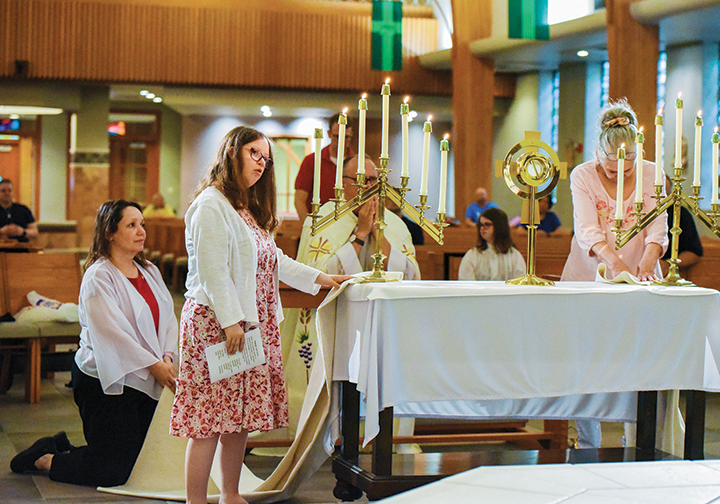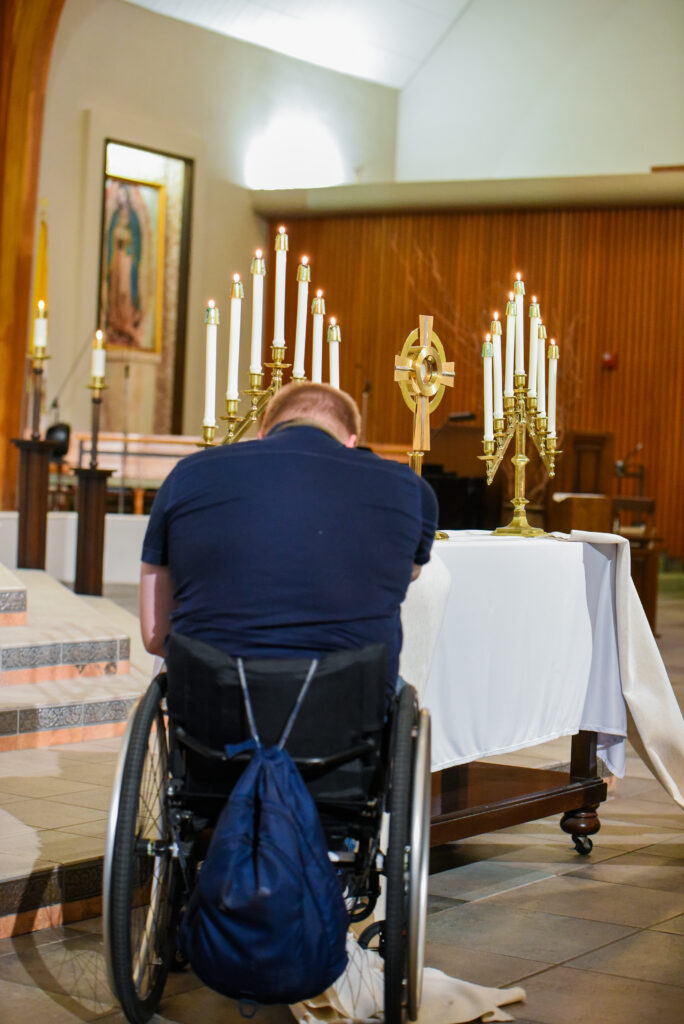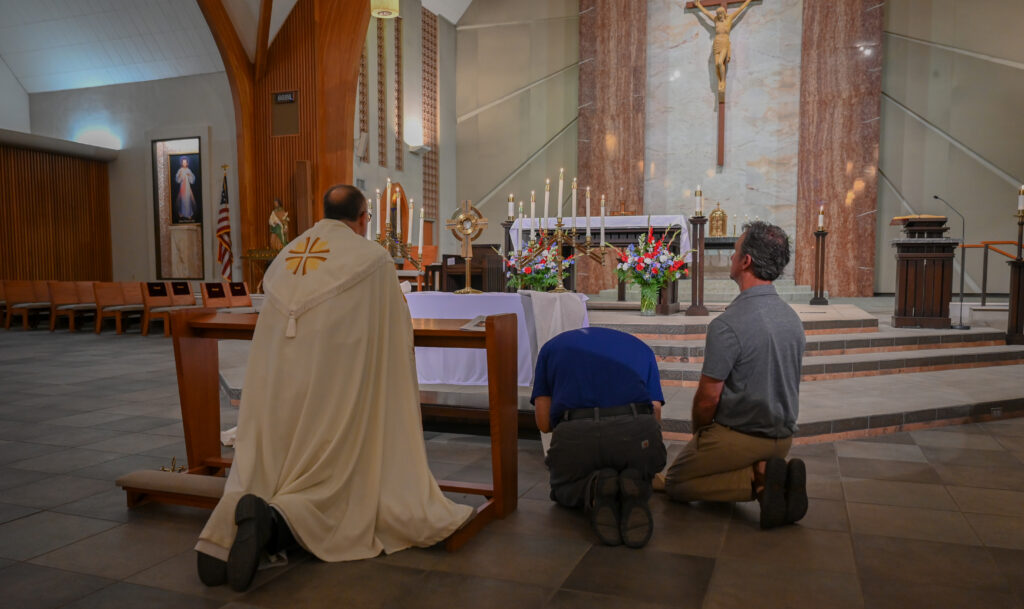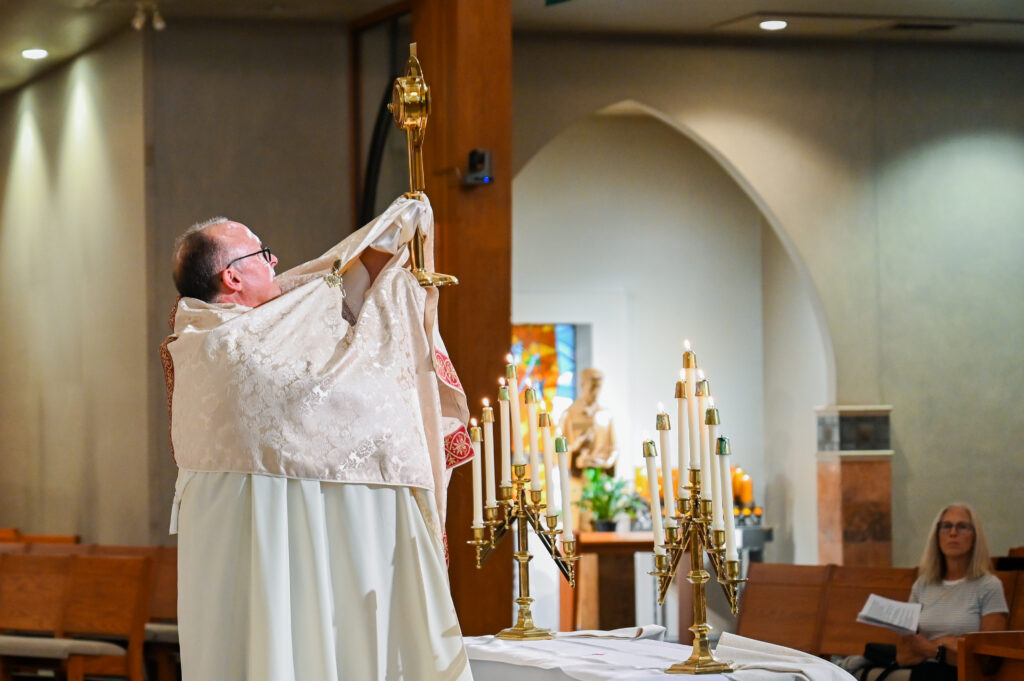
by Tom Racunas
Special to The Leaven
OVERLAND PARK — It was the last day of the National Eucharistic Pilgrimage in the Archdiocese of Kansas City in Kansas. And it might have seemed, at first glance, like the end of something.
Instead, it was just the beginning.
For on June 29, the very first sensory-friendly eucharistic adoration and Benediction was held at Queen of the Holy Rosary Parish in Overland Park.
Beautiful, peaceful, quiet, moving and intimate are just a few of the words that participants used to describe what they experienced.
Sensory-friendly eucharistic adoration is designed to create a welcoming space for persons with disabilities and their families within Catholic faith communities. The liturgy aims to provide a peaceful and accessible environment for all people, regardless of their abilities, to grow in their faith — to believe more deeply that Jesus is truly present in the Eucharist.

Josh Ruoff, lead consultant for the special-needs ministry in the archdiocese, and Lisa Wagner-Carollo, director of deaf and disability services for the Diocese of Kansas City-St. Joseph, serve on the Council for Developmental Disabilities for the National Catholic Partnership on Disability (NCPD).
Ruoff said that when the council discussed the resources available nationally to enhance access and participation for people with disabilities in the life of the church, they realized there were no “how-to” guidelines for eucharistic adoration and Benediction.
“Working with NCPD staff and Lisa,” said Ruoff, “we developed a blueprint for the liturgy which will be shared with dioceses across the country.” The exposition of the Blessed Sacrament on a table closer to the participants, soft music, soft lighting, large-print worship aids, flexible and accessible seating options, a calming area, assistive listening devices, sign language interpretation and the availability of fidget items are possible adaptations suggested in the blueprint.

Before the liturgy began, Father Bill Bruning, pastor of Queen of the Holy Rosary, showed those gathered the monstrance, the luna and the humeral veil, and explained how and why they are used.
Eucharistic adoration, he explained to those gathered, is a quiet time — a time for prayer, a time to give thanks and a time to ask Jesus for help if they or someone they love is sick or hurting.
Father Bruning read from the Gospel of Luke about the woman who was healed from hemorrhages by touching the fringes of Jesus’ clothes. He read it slowly with emphasis and expression so that participants could more easily understand it.
After a few minutes of quiet prayer that followed, Father Bruning then invited the faithful to come forward and touch the long cloth on the altar representing Jesus’ clothes.
“This is between you and Jesus,” he said. “In silence, ask Jesus for healing in your body, mind and heart.”
Nearly every attendee did so.

Denise Gartner brought her daughter Carly, a young adult with severe autism.
“For me, this meant that this is another way that the church is becoming more inclusive,” said Gartner. “It was so low-key and the timing was so good (about 40 minutes), that Carly made it through. We have been to the [eucharistic] adoration chapel before but it was a quick in-and-out. Carly was able to walk to the altar and touch the hem of Jesus’ clothes. It was a very special moment for me.”
John and Heidi Johnson, who volunteer with the iCare Ministries, were also in attendance. This was Heidi’s first Holy Hour, as she is a recent convert.
“I can hardly describe it. It was spiritually healing,” she said. “It was a big reminder to go out with my heart and continue to walk in the path of Jesus.”
The experience was almost overwhelming to some of the faithful.
“I got to be with Jesus,” shared Lucy Wagner, a young woman with Down syndrome, who then broke into tears.
Her mother Annette, however, finished her thought:
“In a special way, right? You got to touch Jesus’ clothes,” she said.
Lucy nodded in agreement.
Bella DeBrevi, also a young adult with Down syndrome, was equally moved.
“I like adoration. I like to pray,” said Bella.
But her mother Teresa saw her daughter’s experience in light of the Eucharistic Revival as well.
“This was a beautiful culmination of the National Eucharistic Pilgrimage that I just participated in,” she said. “Seeing my daughter adore the Lord with her whole heart moved me. This was intimate for her. It brings me comfort that she is able to approach the Lord.”
Following Benediction, there was a social gathering in the courtyard of the church. That extra time spent together, said Lisa Wagner-Carollo, extended the serenity of the experience within the church.
“The reverence was palpable,” she noted.
Even Father Bruning found it an unusually moving experience.
Ministering to people with disabilities, he said, forces him to slow down and answer questions that they need answered.
“I can’t assume anything,” he said. “Everything must be explained. And what can’t be explained — well, we all share in the mystery!”
“The Gospel becomes so incarnate with people with disabilities,” he continued. “I don’t have to think about Jesus 2000 years ago.
“I was moved to tears to be in this holy, sacred space and watch as people approached the altar and touched the hem of Jesus’ clothes.”






